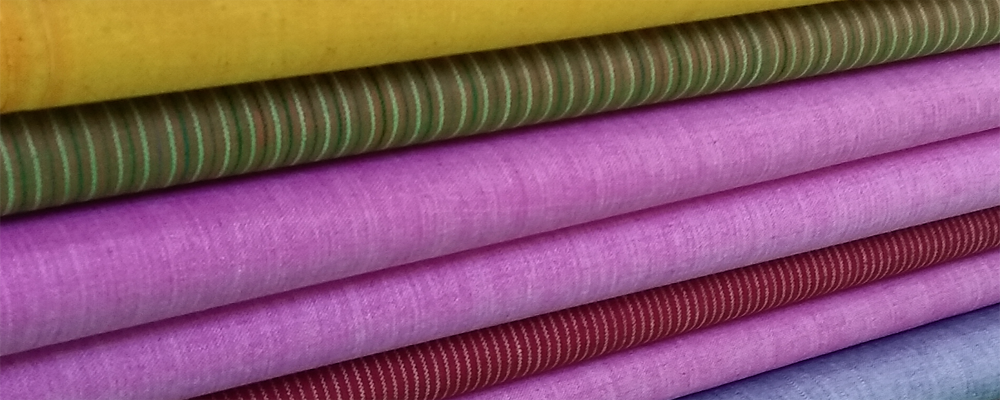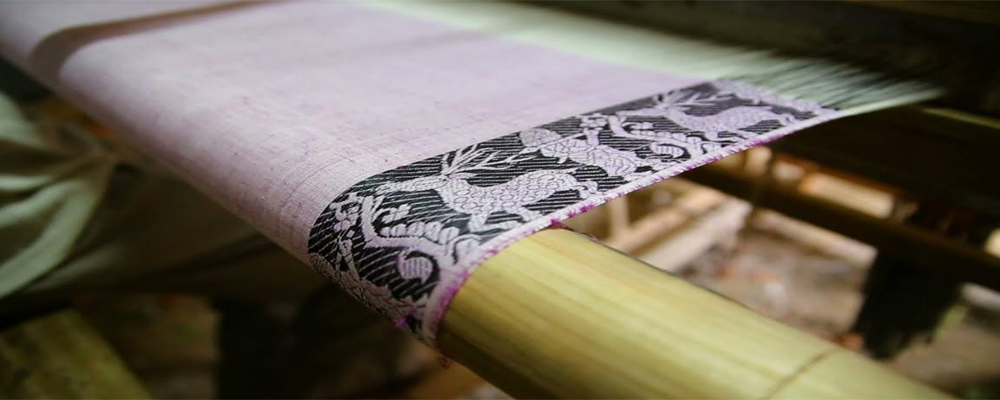![]()
Khadi means any cloth woven by hand from Cotton, Silk or Woolen hand spun Yarn or from combination of any two or all of such yarn. It may also be told that Khadi is a cloth woven by hand using handspun yarn only. Natural fibers namely cotton, wool and silk are used in spinning and the production activities are carried out mainly in rural areas.
Mahatma Gandhi after his return from South Africa in 1915, understood the importance of hand spun & woven cloth in national economy. So he conducted Khadi program as part of freedom struggle. The beauty of Khadi which makes it different from most other fabrics, even hand woven is because of the fact that the yarn being hand spun makes the fabric very airy by allowing fabrics to breathe and thus remain cool even in summer. It is pleasure to note that WBKVIB has been taking adequate initiatives for overall improvements of Khadi. As a result, in the last few years there have been a significant growth in production and employment in this sector. Khadi has now been promoted as the “FABRIC OF THE NATION”. Still today Khadi remains with its Glory. Varieties of Khadi are i) Cotton Khadi, ii) Muslin Khadi, iii) Silk Khadi (Reeled & Spun), iv) Woolen Khadi, v) Polyvastra. Production & use of woolen khadi & polyvastra have been restricted due to warm climatic condition in Bengal.
1. Cotton Khadi:
Khadi is handspun & hand-woven natural fiber cloth made out of cotton yarn (up to 99 count) is considered Cotton Khadi.
COTTON KHADI PRODUCTS:-
- NMC Than (up to 99 count) colored & white.
- cotton saree
- Cotton Gamcha.
2.Muslin Khadi:
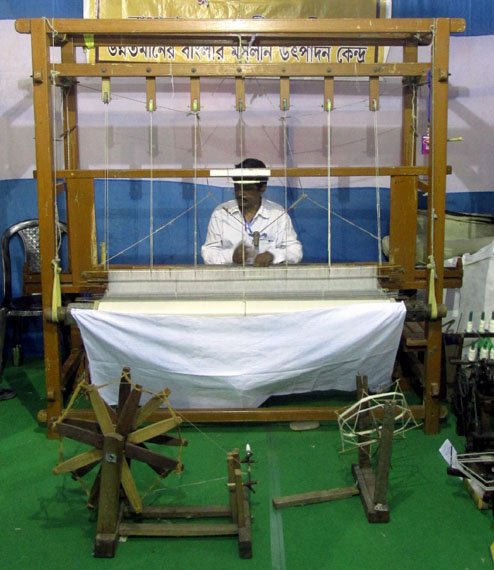 | The word ‘Muslin’ is derived from the name of the ancient port town “Maisolos”. Muslin cloths were traded by ancient Greeks & Romans from the East Indian Port town Masulipattanam, known as Maisolos and the name Muslin originated from the name Maisolos. The fabrics made of fine cotton yarn (100 count and above) are considered as Muslin Khadi. Thus Muslin is defined as cotton fabric made in various degree of fineness. MUSLIN KHADI PRODUCTS:-
| 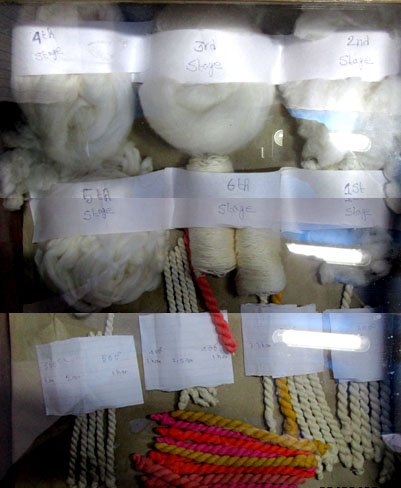 |
3.Silk Khadi:
(REELED):- Silk is a natural protein fiber which is obtained from the cocoons of silk worm. It is a natural filament produced by the salivary glands of silkworms, which are type of moth that feeds on the mulberry bush. The different varieties of silk produced in India from different species of silkworm are mulberry silk, muga silk & tussar silk. The casing formed by the caterpillars of silk worm’s before metamorphosis into a pupa, the raw material of natural silk.
(SPUN):- In the process of production of cocoon to fabrics various types of wastes are produced at different stages for cocoon to fabric/ garments. Normally the wastes (as stated above) are the raw material for the spun silk yarn.
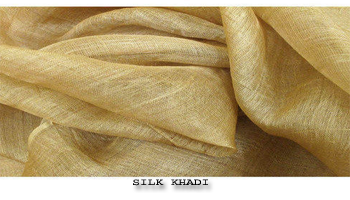 |
SILK KHADI PRODUCTS:-
|

• CHARKHA : A Charkha or Spinning Wheel is a device for spinning thread or yarn from fibres.
• LOOM: A loom is a device used to weave cloth and tapestry by hand. The basic purpose of any loom is to hold the warp threads under tension to facilitate the interweaving of the weft threads. The precise shape of the loom and its mechanics may vary, but the basic function is the same.
• SLIVER: Sliver is the result of the processed cotton, made from drafting lap.
• HANK : One thousand meter yarn length is equals to One Hank.
• BOBBIN : It is a wooden or plastic made device on which the yarn winds during spinning process.
• TRAVELLER : ‘C’ letter shaped or elliptical shaped and is rolled with Ring, is used for the Purpose of inserting and twisting the thread.
• SPINDLE : ‘Stage’ is denoted by the word ‘Spindle’ e.g. 6 spindle means six ‘Stages’ and ‘Count’ may be increased or decreased through the changing of Pinion gear.
• COUNT : The yarn count is a numerical expression which defines its fineness or coarseness. It also expresses weather the yarn is thick or thin. A definition is given by the textile institute-“Count is a number which indicates the mass per unit length or the length per unit mass of yarn”.
Type of yarn count:
a. Indirect system- English, Metric, Worsted.
b. Direct system- Tex, Denier, Lbs/Spindle.
• CATEGORIZATION : Five-tire grading (A+, A, B, C and D) of Khadi and Polyvastra institutions on the basis of the points vis-à-vis rating is known as Categorization. There are as many as twenty (20) parameters used for rating.
• BUDGET : The Khadi Commission formulates budget guidelines every year. These guidelines saved as basic tool for the budget term to discuss and review the Khadi programme implemented by the institutions during previous years, read with their progress in the current financial year and plan of action for the next financial year i.e. budgeting year
• COST CHART : Khadi items can not be sold in any arbitrary rate. KVIC has been issued time to time the rate chart, which is known as Cost Chart.
It is a chart or schedule designed by the KVIC and to be followed by all the Registered Khadi Societies and that is inclusive of-
1.Cost of raw materials + 2. Spinning/Weaving charge + 3. Process wastage + + 4. Artisan Welfare Fund + 5. Trade expenses + 6. Allowable margin
The Cost Chart for the purpose of calculating value of production of ‘Raw Khadi’ to ‘Wet Processing’ stage to serve as the basis of calculating MDA/MMDA.
• ISEC : The Government of India has approved a comprehensive interest subsidy scheme for institutional financing of the Khadi and Village Industries Programme, called ISEC.
• QUANTUM OF SUBSIDY (ISEC):- The difference between the actual rate of interest charged by the bank minus 4% (to be borne by the borrower). [e.g. if Bank interest is 13%, then (13-4)=9% is subsidy i.e ISEC].
• PRIME COST : The prime cost means the cost of raw material plus conversion charges up to grey cloth plus processing charges but does not include provision for trade expenses (3%), bank interest (4%), insurance (1%) etc & allowable establishment margin.
• MMDA : The Modified MDA shall be calculated at 15% on Prime Cost of production and payment will be initiated time to time subject to availability of MMDA budgetary fund to be received from the State Govt.
• KHADI MARK : It has become mandatory for all the Khadi Producing Institutions to get registered for “KHADI MARK” certificate for genuineness of Khadi. The Khadi Institutions who have obtained the “KHADI MARK” Certification shall only be considered for enlistment under Govt. supply.
• WASTAGE : Waste refers to that part of raw materials which is lost during processing. It is also admissible and count during actual costing of the product.
• WORKING CAPITAL : Funds by Khadi Institution are required for carrying out day to day activities i.r purchase of raw materials and components, Payment of wages, payment to AWFT (Institution’s share) and other recurring expenses known as Working Capital. It is also known as Revolving or Circulating Capital. This is required for smooth running of the Khadi Institutions.
• Aam Aadmi Bima Yojana : This scheme, like other Group Insurance Schemes, does not have any terminal benefit for the beneficiaries as this is not a Life Insurance Scheme. The scheme provides only risk cover for death/ disability and the worker is not
entitled to get any returns on the premium paid by him or paid on his behalf by KVIC/ Khadi institution, if he survives the entire period of insurance.
Benefits: The Shiksha Sahayog Yojana is add-on coverage under AABY, without any additional premium. The wards of the khadi artisans (benefit restricted to two children per member/family) covered under the AABY are entitled to receive up to Rs. 1200 per annum per ward towards tuition fee.
Amount of Premium:-The premium payable has been fixed at @Rs. 1OO/-.
a. The contribution from social fund (Govt. of India): Rs. 50.00
b. Institutions contribution: Rs. 25.00
c. KVIC: Rs. 12.50
d. Artisan: Rs. 12.50
Rs. 100.00
• AWFT : Depositing of Artisan Welfare Fund into the State Level Artisan Welfare and Pension Trust (AWFT) by Khadi Institutions is must (12% Artisan’s Share + 12% Institution Share). In fact as available in the balance sheet the AWF is to be deposited to the State level Trust
completely by each and every Khadi Institutions. The status of the AWF vis-à-vis depositing the same to Artisan Welfare Fund and Pension Trust should find a place in the record note of the institution.
• PRODIP SCHEME : KVIC has been implementing the scheme for "Product Development, Design Intervention and Packaging" from November 2002 onwards. The KVIC will continue to implement the scheme on "Project Approach" basis, that is activities, will be approved as individual projects.
• SFURTI SCHEME : India has a rich tradition in traditional industries. The eco-friendly products of traditional industries not only have great potential for growth in production and export but can also lead to widespread generation of employment opportunities in the rural areas of the country. With a view to make the traditional industries more productive and competitive and facilitating their sustainable development, the Central Government announced Scheme of fund for regeneration of tradi¬tional industries.
• WORKSHED SCHEME : The Workshed Scheme for Khadi Artisans (WSKA) is an attempt to facilitate the development of khadi spinners and weavers by way of providing them financial assistance for construction of worksheds.
• KRDP SCHEME : To fulfill the social commitment of Khadi & V.I. (Polyvastra) Programme implementation in Hill, Border and Left Wing Extremism affected areas by the institutions working in those areas and nearby institutions interested to work there, Commission in its 621st meeting held on 28.01.2014 agreed for extension of financial assistance under KRDP. The eligible institutions will be provided assistance on merit of their need based proposal within ceiling limit of assistance.



